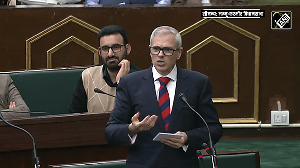Scripting success on the maiden operational flight of its heavy-duty rocket fitted with the indigenous cryogenic upper stage, India on Thursday launched its advanced weather satellite INSAT-3DR onboard GSLV-F05 from the spaceport in Sriharikota.

The 49.13-metre tall rocket lifted off from the second launch pad at the Satish Dhawan Space Centre here at 4.50 pm, majestically soared into the skies and injected the 2,211-kg INSAT-3DR into a Geosynchronous Transfer Orbit about 17 minutes later.
Earlier, it was scheduled to lift off by 4.10 pm but due to "delay in cryostage filling operations" it was rescheduled to 4.50 pm, officials said.
INSAT-3DR, with a designed mission life of ten years, will provide service continuity to earlier meteorological missions and further augment the capability to provide various meteorological, search and rescue services.
Thursday's mission, the 10th flight of GSLV, assumes significance for the Indian Space Research Organisation as it is the first operational flight of the rocket fitted with the indigenous cryogenic upper stage.
Earlier, GSLV launches with indigenous cryogenic stage were under 'developmental' phase.
GSLV-F05 also marked a hat-trick of success for the indigenously developed complex cryogenic upper stage after GSLV-D5 (January 2014) and D6 (August 2015) missions, which had launched GSAT-14 and GSAT-6 satellites into precise orbit.
"Today's launch of GSLV-F05 is significant since it is first operational flight of GSLV carrying Cryogenic Upper Stage. Earlier launches were developmental. The engine used was Russian engine. Today's launch is indigenous Cryogenic Upper Stage and it is the first operational flight," an Indian Space Research Organisation official told PTI.
The 2014 success had propelled India into the elite group of countries boasting of the homegrown complex cryogenic engine and stage after twin failures in 2010.
A jubilant ISRO Chairman A S Kiran Kumar patted his team of scientists for "another achievement" even as he said the satellite was placed in the orbit.
P Kunhikrishnan, Director, Satish Dhawan Space Centre SHAR (SDSC SHAR), said Thursday's was a 'precision launch' where the satellite was placed in a "very accurate geosynchronous orbit."
"Hearty congratulations to the entire ISRO team for the wonderful job you have done. Keep it up," Kiran Kumar said.
It was the seventh successful mission this year including the IRNSS series and the scramjet propulsion mission and it had been conducted with "utmost professionalism in the short period possible," Kunhikrishnan said.
Vikram Sarabhai Space Centre Director L Sivan, described the GSLV success as "our beloved Make in India" technology.
"The mission lifted the highest mass satellite... GSLV MKIII is going to lift the highest mass satellite on Indian soil in another three months," he said.
After the INSAT-3DR is placed in orbit, scientists at Master Control Facility at Hassan, Karnataka would perform the initial orbit raising manoeuvres and later place it in circular geostationary orbit.
"This process may take place a few days after launch," the ISRO official said.
INSAT-3DR would supplement the services of INSAT-3D launched from French Guiana on July 26, 2013.
The payloads in INSAT-3DR are Imager, Sounder, Data-Relay Transponder and Satellite Aided Search and Rescue Transponder.
The multi-spectral 'imager' would generate images of earth every 26 minutes. It would provide information on various parameters, sea surface temperature, snow cover, cloud motion winds.
It is an improved version of similar imager that was used on INSAT-3A and Kalpana-1 Satellites.
The ‘sounder' payload, which was earlier used in INSAT-3D, will provide information on temperature and humidity.
The Data-Relay Transponder would be used for receiving meteorological, hydrological and oceanographic data.
The Satellite Aided Search and Rescue Transponder would pick up and relay alert signals originating from distress beacons of maritime, aviation, among others.
INSAT-3DR would join INSAT-3A and INSAT-3D to provide operational search and rescue service.










 © 2025
© 2025